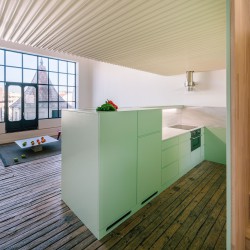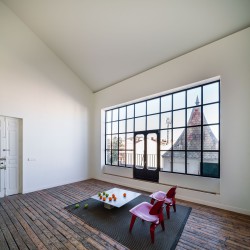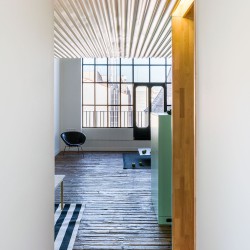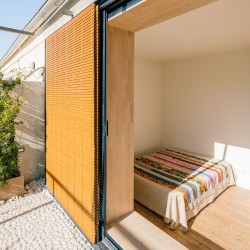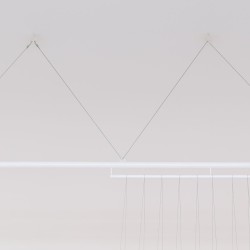Langarita Navarro Arquitectos . photos: © miguel de guzmán + rocío romero | imagen subliminal
Attics comprise a peculiar urban geography. As the tops of buildings, they can reveal surprising singularities that are hard to imagine when one is strolling through a city at ground level. Cupolas, pavilions, terraces and towers share the space with leafy plantations, delusions in textile, illegal transparent enclosures and sloping tiled roofs. This project is linked to this world of fantasy, which it exploits through the restoration of the site’s stunning original features and the invention of architectural operations close to woodwork and gardening.
_
Located on a characteristic street in Madrid’s Barrio de Salamanca, the attic forms part of the seventh floor of a typical bourgeoisie twentieth-century building. It originally housed an Academy of Fine Arts. In essence, it possesses all of the qualities of traditional painting studios: a principal volume with a soaring gabled roof, which reaches a height of 7 meters at the ridge beam and boasts a large north-facing bank of iron-framed windows that provide an even illumination to the work space. The rest of the structural elements are made up of smaller volumes arranged around two interior patios and the building’s rear facade. The setbacks on the facades make it possible to enjoy the outdoors in two singular spaces. On the north side, there is an elongated terrace with direct views of a picturesque turret. The south terrace offers an expansive and wonderfully-oriented space with large enough dimensions to be thought of as a whole other room.
The project followed two strategies. The first was to maintain all of the singular features that made the original space so unique: we respected the striking volume, the beautiful divided panes of the picture window, the old pine floors and the original wood doors. The second was to work on the space through specific operations that were coherent with the logic of the building of large-scale furniture or garden elements. In the main area, we rebuilt a precarious loft using a solution that resolved both structural and air conditioning issues, minimizing its visual impact. The space under the loft was used for the kitchen, the staircase to the next level and storage. In the rooms, a wall of closets and a window form a permeable border with the exterior. The south terrace was conceived of as another room, in which a network of climbing vines (roses, wisteria, ivy and jasmine) will create an aromatic, intimate and hedonistic oasis.
_
Project: Penthouse H
Location: Madrid
Architects: María Langarita and Víctor Navarro
Collaborators: Policarpo del Canto, Havi Navarro
Builder: Manuel Ocaña Fast & Furious Production Office SL
Structures: Mecanismo
Installations: Mecanismo
Garden design: Ambienta
Date: 2017
Client: Private
Los áticos forman una peculiar geografía urbana. Su condición de remate de lo edificado suele dar lugar a sorprendentes singularidades apenas imaginables cuando uno pasea a ras de suelo de la ciudad. Cúpulas, templetes, terrazas y torreones conviven con frondosas plantaciones, delirios textiles, transparentes cerramientos ilegales y cubiertas de teja inclinadas. Esta reforma se vincula a ese mundo fantástico y lo explota mediante la restitución de las asombrosas cualidades originales y la invención de operaciones arquitectónicas próximas a la ebanistería y a la jardinería. Ubicado en una característica calle del Barrio de Salamanca de Madrid, el ático formaba parte de la sexta planta de un típico edificio burgués de principios del siglo XX. Su función original era la de academia de pintura. Su genética posee las cualidades de los tradicionales estudios de pintura: un volumen principal a dos aguas con una altura generosa, llega a los 7 metros en la cumbrera y un gran ventanal de hierro orientado a Norte para una iluminación homogénea del espacio de trabajo. El resto de los elementos construidos lo componían unos cuerpos menores en torno a dos patios interiores y la fachada trasera. Los retranqueos a las fachadas permiten disfrutar del exterior en dos singulares espacios. A norte una terraza alargada introduce en el primer plano de vistas un torreón con un pintoresco remate. La terraza sur, deja un espacio generoso y fantásticamente orientado, con dimensiones suficientes para ser considerada una habitación más. El proyecto ha seguido dos estrategias. La primera, mantener todas aquellas condiciones singulares que hacían del espacio original un lugar único: se han respetado el impactante volumen, el bello despiece del ventanal, el envejecido suelo de pino o las puertas de madera originales. La segunda, intervenir sobre el espacio con operaciones puntuales vinculadas a las lógicas de la construcción de mobiliario o jardinería ampliadas de escala. En el cuerpo principal se ha rehecho un precario altillo con una solución capaz de resolver estructura y climatización minimizando el impacto visual. El ámbito bajo el altillo sirve para resolver la cocina, la escalera de subida y el almacenamiento de la casa. En las habitaciones un cuerpo de mobiliario y ventanal construye un límite permeable con el exterior. La terraza sur se ha configurado como una habitación más en el que la red de trepadoras (rosales, glicinias, hidras o jazmines) acabara por crear un espacio oloroso, intimo y hedonista.






